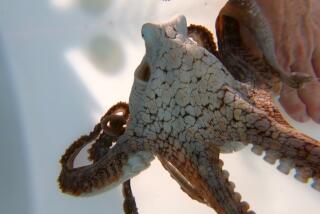Wild or farmed? Pacific or Atlantic? Here’s what to know about bluefin tuna

Although bluefin tuna is commonly found at sushi restaurants throughout Los Angeles, many diners might not be aware of what it means to eat a particular species or how it’s sourced. The more you know about bluefin tuna, the better equipped you are to make decisions about whether to consume it.
Known for its blueish-black and silver hues and torpedo-shaped body, bluefin tunas are magnificent creatures with ravenous appetites. Large and fast, they can swim up to 43 miles per hour. There are three species of bluefin tuna, each with its own unique migration pattern, varied diet, size and lifespan.
Served nearly everywhere to sushi lovers, whether or not we should be eating bluefin tuna still is still hotly debated among consumers and conservation experts alike.

Pacific bluefin tuna are born in the Sea of Japan before making a 5,000-mile-plus migration to the California coast, where they feed and grow for years. They travel up and down the Pacific coast between Mexico to Washington before trekking back to Japan to spawn. While Pacific bluefin tuna can live up to 26 years, their average lifespan is 15. A Pacific bluefin typically reaches maturity at 5 years old, and adults are about 5 feet long and 130 pounds. Predatory creatures, their diet usually consists of squid and fish like sardines and anchovies.

Atlantic bluefin tuna spawn in the Gulf of Mexico and Mediterranean Sea and migrate across the eastern and western Atlantic Ocean. They’re often fished and ranched in Spain, Malta and Croatia, as well as Boston and Canada. The largest of the three species of bluefin, they can live more than 20 years and grow to 13 feet and 2,000 pounds. The adults feed on fish like herring, bluefish and mackerel.
Southern bluefin tuna spawn in the Indian Ocean and migrate across the Pacific, Atlantic and Indian oceans. They’re fished in Australia, New Zealand, Indonesia and South Africa. They can live up to 40 years, and grow up to 8 feet long and more than 550 pounds. They feed on fish, cephalopods (like squid and octopus), crustaceans and salps.
This is your guide to what the best sushi city in America has to offer, from the ultimate California roll to spectacular omakase.
Monterey Bay Aquarium’s sustainable-seafood program “Seafood Watch” recommends consumers avoid eating all types of bluefin tuna, whether wild-caught or farmed, but its population status is complicated and data are always in flux. Some experts say it is OK to eat all three species at this juncture because fish management has improved tremendously in the last decade, though Pacific bluefin regulations have only recently been proven to be more effective.
Bluefin tuna can be wild-caught, farmed or ranched. Here is how they’re sourced:
Wild: There are bluefin tuna that are caught in the wild in a number of ways, from purse seine (a large netting), to trolling (luring through lines of bait) and harpoon gear. A main issue is bycatch: fisheries incidentally also catching other important but non-target creatures from the ecosystem.
Ranched: Most of the “farmed” bluefin tuna are actually considered “ranched.” When a bluefin tuna is ranched, fish farmers will catch juvenile ones in the wild and move them into pens, where they are fattened until they reach sushi-grade quality and sold in the markets. But they’re still technically considered wild even if they’re ranched since fisheries still pluck them from the wild stock.
Farmed: There is an effort with bluefin tuna, particularly the Pacific species, called “closed-cycle farming” that’s more like true fish farming. Fish eggs from farm-raised parents are artificially hatched into larvae in laboratories and then transferred to ocean pens. Kindai University (formerly known as Kinki University) in Japan was the first in the world to succeed in captive breeding with a fully farmed bluefin tuna in 2002. Others have followed suit, but still, it’s a niche product and the amount that enters the market is too small to make a major impact at the moment.
In regard to taste, farmed and ranched bluefin tuna are considered fattier than wild-caught. The flavor profiles are different as well. Since farmed bluefin tuna is typically fed pellets and sardines, the taste is different from wild tuna with a varied diet, which often results in more complex flavors.
More to Read
Eat your way across L.A.
Get our weekly Tasting Notes newsletter for reviews, news and more.
You may occasionally receive promotional content from the Los Angeles Times.









